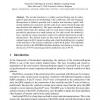Free Online Productivity Tools
i2Speak
i2Symbol
i2OCR
iTex2Img
iWeb2Print
iWeb2Shot
i2Type
iPdf2Split
iPdf2Merge
i2Bopomofo
i2Arabic
i2Style
i2Image
i2PDF
iLatex2Rtf
Sci2ools
BIOSTEC
2008
2008
A Supervised Wavelet Transform Algorithm for R Spike Detection in Noisy ECGs
Abstract. The wavelet transform is a widely used pre-filtering step for subsequent R spike detection by thresholding of the coefficients. The time-frequency decomposition is indeed a powerful tool to analyze non-stationary signals. Still, current methods use consecutive wavelet scales in an a priori restricted range and may therefore lack adaptativity. This paper introduces a supervised learning algorithm which learns the optimal scales for each dataset using the annotations provided by physicians on a small training set. For each record, this method allows a specific set of non consecutive scales to be selected, based on the record's characteristics. The selected scales are then used for the decomposition of the original long-term ECG signal recording and a hard thresholding rule is applied on the derivative of the wavelet coefficients to label the R spikes. This algorithm has been tested on the MIT-BIH arrhythmia database and obtains an average sensitivity rate of 99.7% and aver...
| Added | 29 Oct 2010 |
| Updated | 29 Oct 2010 |
| Type | Conference |
| Year | 2008 |
| Where | BIOSTEC |
| Authors | Gael de Lannoy, Arnaud de Decker, Michel Verleysen |
Comments (0)

